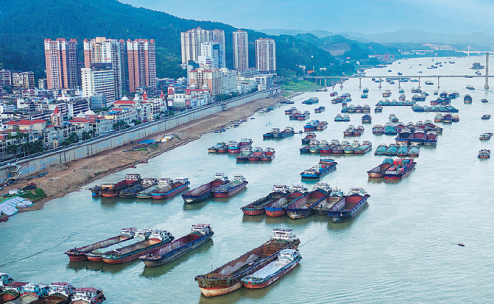Pinglu Canal project gets environmental approval

Barges sail on the Xijiang River in the Guangxi Zhuang autonomous region, in May. HE HUAWEN/FOR CHINA DAILY
The Pinglu Canal project passed its environmental impact assessment review on May 31.
A team of experts, including three academicians from the Chinese Academy of Sciences, reviewed the EIA report at a meeting in Nanning, capital of the Guangxi Zhuang autonomous region.
Development of the canal was approved in March.
Stretching 140 kilometers and requiring an estimated investment of 68 billion yuan ($10.7 billion), the canal will link the Xijiang River, a major waterway in southwestern China, with ports in the Beibu Gulf.
It will start at the Xijin Reservoir in Hengzhou and end at Luwu town in Lingshan county, where ships will be able to reach the gulf via the Qinjiang River, opening a shorter route to the sea for Guangxi and other southwestern regions.
Local authorities plan to begin construction later this year, according to Guangxi's department of transport.
Xu Yongke, the region's vice-chairman, said at the technical review meeting that the canal will greatly help Guangxi better serve national strategies by improving water transportation for trade between China and the ASEAN members, forming a comprehensive three-dimensional transportation network and speeding up regional economic development.
While the team of experts deemed the report comprehensive, its scope and methods of assessment in line with standards and the recommended protective measures and conclusions convincing, they also proposed a few improvements on aspects such as the protection of biodiversity, riverine restoration and environmental risk prevention and control.
"These suggestions will play an important supporting role in ensuring the construction of the best possible project," Xu said.
He urged the report's compilers and the project's construction units to consider these additional suggestions and clarify environmental protection measures to strengthen the report and get the project underway as soon as possible.
Cheng Hongqi, Party secretary of Guangxi's department of transport, pointed out that the report is an important part of feasibility studies and lays a solid foundation for the construction of a green canal.
The parties in charge of the EIA report will perfect the report and resubmit it to the region's environmental department for approval, Chen said.
In 1992, Guangxi compiled the preliminary work report on the canal's construction and determined the route plan. Guangxi started a feasibility study for the canal last year, according to the region's department of transport.
The canal is an important part of the new western land-sea corridor, which connects major inland cities in southwestern China such as Chongqing and Chengdu, capital of Sichuan province, with coastal and border cities in Guangxi.
It will also act as a new strategic channel to link the international hub ports in the Beibu Gulf and Xijiang River.
It will be built to a Class I inland waterway standard, which will allow the navigation of 5,000-metric-ton ships.
After the project is completed, Guangxi will have a new sea access point. Ships on the middle and upper reaches of the Xijiang can sail out to sea from the Beibu Gulf via the canal, a distance 560 kilometers shorter than from Guangzhou Port in Guangdong province.














